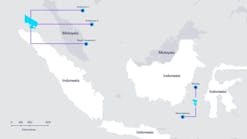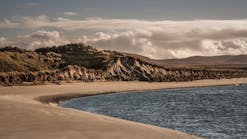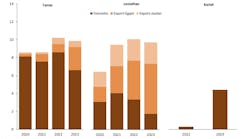Fred Akani
Lagos
Exxon's ultra deepwater prospect a disappointment
Disappointing results from Bosi-1, Exxon's first deepwater well in Nigeria, may substantially douse optimism for investment in the six newly carved out leases in the outer deep offshore. At 1,400 meters water depth, Bosi-1 is the farthest adventure in the deepwater off the coast of West Africa.
The new leases, in water depths between 1,500 to 2,500 meters, were carved out by the state Department of Petroleum resources in the wake of Shell's huge success with Bonga-1 (water depth = 1,100 meters) and Exxon's decision to drill Bosi-1 in 1,400 meters water depth).
Exxon plugged and abandoned Bosi-1 with gas and very small oil shows at 14,206 ft after drilling for nearly 200 days with severe pressure conditions. The well was twice sidetracked, as the mud and claystones which made up most of the formation clung to the drill pipe, creating mechanical problems. The sands that were encountered were occasional streaks.
The lack of much hydrocarbon in Bosi-1 is going to discourage some of us who are interested in the outer deepwater , said a source in Conoco office in Houston. For the sheer risk involved, the new outer deepwater leases are certainly not in want of new customers. Conoco is rooting for two outer deepwater leases. Chevron may be interested in one. Some Nigerian companies have also applied. As at the time of this report, the DPR has not awarded any of them.
Ranger abandons Angola Block 4 well
Ranger Oil has plugged and abandoned the exploration well 4/22-1 offshore Angola. They are now drilling Kiame-3, 11 kilometers away. The Kiame Field is expected to be onstream by December 1997.
Cote d'Ivoire's awardsBlocks CI-104 & CI-105
State-owned Petrocci has finally agreed on a production sharing contract with Global Natural Resources for Block CI-104, covering 250,300 acres in shallower water portion (200 meter water depth) of former Block CI-31, west of United Meridian's Block CI-12. CI-104 lies immediately west of Block C-12 and C-11. Block C-11 is producing about 16,000 BOPD of oil and 5,500 MCF/day of gas. GNR hopes that a partner will join them on the block before the drilling phase. The deepwater portion of CI-31 was redesignated Block CI-105, and has recently been awarded to Shell Exploration.
Exploratory tests are scheduled to be drilled on both CI-11 and CI-12 before the year end. The contract allows three exploratory periods of two years each, with a 25 year development period for any discovery.
The work program requires GNR to reprocess 2,000 km of 2D seismic, shoot 350 sq km of 3D seismic and drill at least one exploratory well.
Mobil succeeds again in Equatorial Guinea
Even as the Zafiro Field has been put in production, Mobil continues its success streak in this small aquatory southeast of Nigeria. The company has just suspended Amatista 1, located south of the Zafiro Field, which penetrated down to a deeper sequence than the main Zafiro sands. The well was not drill stem tested. The TD was 11,378 ft (3,468 meters) and the water depth was 1,220 ft (372 meters). The deepest casing run was to 7721 ft (2,353 meters). Amatista's objectives were arguably a drape over a leading edge thrust feature. The drape is apparently the intra Qua Ibo sands, which is genetically related to the producing sequence in the main Zafiro Field. A comparable thrust feature was encountered in Delta-1, northwards in the same lease and Mfon-1, drilled by Conoco but these were dry.
Congo production growing by leaps and bounds
Things keep looking up for Congo. By the end of the year, the 400 million barrel N'Kossa Field offshore will be delivering 120,000 b/d. For a field that came on stream in June 1996, this is exceptionally speedy gush.
Even in Nigeria, the production rates in big fields do not routinely get higher than 100,000 b/d. In 1993, the field with the highest production rates in Nigeria was Shell's Nembe Creek, with a production of 94,000 b/d. But Congo is enjoying a high noon. Last year, the oil patch shook with news of the Moho Field located in 800 meters of water. With cumulative flow rates of 5,700 b/d in two sands, the Moho discovery helped, in part, to double Congo's recoverable reserves to 1.5 billion bbl, from 800 million bbl in 1994. Its gas reserves increased to 4.3 tcf from 2.7 tcf. In August 1996, Moho Marine-2 tested 4,700 b/d in a location five km due north of Moho Marine-1. The field is still undergoing evaluation, and development programme will only come when more seismic data has been acquired and interpreted by operator Elf. Still, the economics look good, with production facilities a mere 15 km away at N'Kossa. Other companies who are in the production sharing contract for Moho are Chevron, Hydro-Congo, and Engen, with 30%, 15%, and 4% stakes respectively.
Namibia's losing streak continues with chevron abandonment
When Chevron first forayed into offshore Namibia, 20 years ago, they found only gas in the virgin formations and hurried away disappointed. Now they are back, but there is no magic to halt the losing streak in the young southwest African country -which is desperately in need of its own homegrown energy and all the resources it could harness for development.
Until recently, Namibia was one of the busiest sites of deepwater exploration. In 1993, the Norwegian company Norsk Hydro drilled a dry hole in 491 meters of water. Last year they suspended another, with minor oil shows. Ranger Oil plugged the 2213/6-1 well, located in 218 meter water depth in the Southern Walvis Bay Basin after drilling to 2,605 in rocks of Mesozoic age. In August this year, Chevron plugged and abandoned 2815/15-1 which is located in 180 meters water depth.
Copyright 1997 Oil & Gas Journal. All Rights Reserved.




